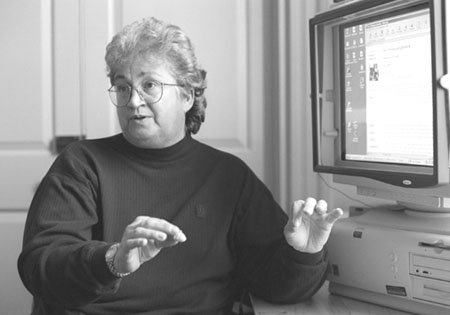Breaking the Glass Ceiling…Online

When Pam Whitehouse, an HGSE doctoral student and adjunct professor at the University of Massachusetts at Dartmouth, put her Women’s Studies 101 course online four years ago, she got a lot of resistance from her colleagues. The Web didn’t jibe with long-held ideologies that women’s studies courses must focus on face-to-face discussion and community, said her critics.
After years of successfully using the Web as a teaching tool, Whitehouse received an award from UMass last month for her exemplary practice in online education. Even so, that same day, she received a phone call from the university’s director of Women’s Studies. “She was very concerned about the teaching of women’s studies online, and she wanted to talk to me about it-seriously and soon,” Whitehouse says.
Not surprisingly, Whitehouse decided to focus her research on gender equity in new technologies. “If we, as leaders in thinking about women’s place in the world, don’t model how new technologies can be used to advance women, who is going to?” she asks.
The controversy surrounding online women’s studies courses points to larger inequities in computer use across the genders, she says. Studies have shown that elementary-age girls use computers at about the same rate as boys. A study conducted by the American Association of University Women on tech-savvy girls found that, by junior high, girls tended to view computer use as antisocial. In high school, girls make up only 17 percent of computer science AP classes; in college, they earn less that 28 percent of computer science degrees. As a consequence, women hold roughly one-fifth of professional IT jobs.
“People often ask, what would social policy look like if more women were legislators?” says Whitehouse. “Well, I wonder what the World Wide Web would look like if women had designed it.”
Whitehouse herself readily took to the Internet. She first encountered the Web as an undergraduate in 1994 when her professor brought her class to a library computer lab. “I was absolutely fascinated. I didn’t even hear the class leave,” she recalls.
To get at the question of why most women don’t have the same affinity for computers, Whitehouse is designing computer-based courses that do work for women, drawing from feminist models of instruction that stress discussion and personal rapport. Using instant messenger, posting boards, chat rooms, and e-mail, Whitehouse provides “multiple entry points” for student participation, and she facilitates discussion around the clock.
Whitehouse’s students, mostly women, eagerly adapted to digital interaction. In a 10-week course last summer, 20 students made some 3,000 posts in the main chat room. And they regularly attended virtual office hours from 9 to 10 o’clock at night-before most of them go out, she says. “I’m trying to meet them where they are instead of making them come to me. I think that makes a big difference in the way they approach learning.”




